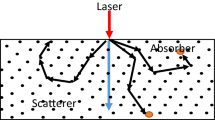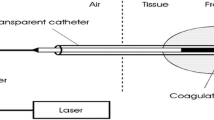Abstract
A two-layer model using different properties for the pathological tissue and the normal tissue was developed to describe the spatial photon, temperature and thermal damage distributions during laser-induced interstitial thermo-therapy (LITT). The photon distribution was simulated using the Monte Carlo method. The optical tissue parameters and the blood perfusion were derived based on the Arrhenius rate process formulation of thermal damage and kinetics of vasodilatation. The corresponding temperature distribution was numerically calculated using the Pennes bio-heat equation. The calculated results showed that the two-layer model predicted different results on the temperature variation and distribution, the thermal damage distribution and the thermal damage volume etc. from the one-layer model. As a more reasonable physical model, the two-layer model can be used to optimize the therapeutic parameters for improved LITT treatments.









Similar content being viewed by others
References
Niemz MH (1999) Translated by Z. X. Zhang. Laser-tissue interaction. The front page. Xi’an: Xi’an Jiaotong University Press. pp 45–67
Roggan A, Müller G (1994). 2D-computer simulations for real-time irradiation planning of laser induced interstitial thermotherapy (LITT). SPIE 2327:242–251
London RA, Glinsky ME, Zimmerman GB, Bailey DS, Eder DC, Jacques SL (1997) Laser-tissue interaction modeling with LATIS. Appl Optics 36(34):9068–9074
London RA (1999) Numerical simulations of a diode laser BPH treatment system. SPIE 3601
Guoxiang Xu (1998) Laser medicine. The people’s Sanitation Press, Beijing
Germer CT, Roggan A, Ritz JP, Isbert C, Albrecht D, Müller G, Buhr HJ (1998) Optical properties of native and coagulated human liver tissue and liver metastases in the near infrared range. Lasers Surg Med 23:194–203
Takata AN, Zaneveld L, Richter W (1977) Laser-induced thermal damage in skin. USAF School Aerospace Med, Rep. SAM-TR-77–38
Kim B-M, Jacques SL, Rastegar S, Thomsen S, Motamedi M (1996) Nonlinear finite-element analysis of the role of dynamic changes in blood perfusion and optical properties in laser coagulation of tissue. IEEE, Journal of selected topics in quantum electronics 2(4):922–933
Wang LH, Jacques SL, Zheng LQ (1995). MCML-Monte Carlo modeling of light transport in multi-layered tissues. Comput Methods Programs Biomed 47:131–146
Luo QM, Gong H, Liu XD (1995) Simulation and inspection of laser transport in biological tissue. ACTA Photonica Sinica 24(2):125–129
Manns F, Milne PJ, Salas N (1999) Mathematical analysis of the temperature field during ex vivo and in vivo experimental laser interstitial thermotherapy (LITT) in breast tissue models. SPIE 3590:448–454
Jode ML (2000) Monte Carlo simulations of light distributions in an embedded tumor model: studies of selectivity in photodynamic therapy. Lasers Med Sci 15:49–56
Tang JM, Liu AQ (2000) Physical course and clinical significance of laser transport in tissues. Laser Journal 21(1):62–63
Lubashevsky IA, Priezzhev AV, Gafiychuk VV (2000) Laser induced heat diffusion limited tissue coagulation as a laser therapy mode. SPIE 3914:66–74
Goldberg SN, Kruskal JB, Gazelle GS (1999) Thermal ablation therapy for local malignancy. A unified approach to underlying principles, techniques and diagnostic imaging guidance. SPIE 3594:2–13
Liu J, WangCC (1996) Bio-heat Transfer. The front page. Science Press, Beijing. pp 1–25
Ma N, Li HJ, Zhang XX (2001) Simulation of photon and heat transport with the Monte Carlo method during laser-induced interstitial thermotherapy. Conference of Chinese Engineering Thermal physics Academy. Beijing: Chinese Engineering thermal physics Academy, 610–614
Acknowledgments
This work was supported by a National Natural Science Foundation Award, Grant No. 50276032.
Author information
Authors and Affiliations
Corresponding author
Rights and permissions
About this article
Cite this article
Ma, N., Gao, X. & Zhang, X.X. Two-layer simulation model of laser-induced interstitial thermo-therapy. Lasers Med Sci 18, 184–189 (2004). https://doi.org/10.1007/s10103-003-0278-2
Received:
Accepted:
Published:
Issue Date:
DOI: https://doi.org/10.1007/s10103-003-0278-2




